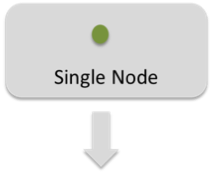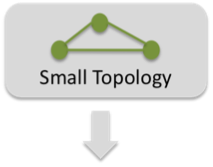| Version 9 (modified by , 10 years ago) (diff) |
|---|
A Tutorial on Systematic Experimental Design
Overview
This tutorial will guide you how to conduct systematic experimentation on GENI. We will setup a layer-3 virtual network environment for routing experiments through this tutorial. In this tutorial, you will learn how to conduct systematic experimentation step by step by a case study.
Systematic Experimental Design Flow
The flow diagram below shows general steps:
- Install Software
- Start with smallest network, usually single node.
- Configure and run experiments on smallest reasonable network
- Automate Experimental Configuration
- End-to-End Validation
- Automate Measurement
- Scaling Up the Experiments
- Increasing the number of aggregates
- Increasing the number of nodes with one aggregate
- Increasing both aggregates and nodes.

Objective of the Case Study
In the case study, we will create a layer-3 virtual network that is composed of virtual routers running OSPF protocol. We aim to observe the OSPF routing table updates under both link and node failures. We will go through every step in the flow diagram above to illustrate how to deploy this experiment systematically using GENI testbed, in particular, using InstaGENI aggregates.
- I: Turn a VM into a virtual router (i.e., software router running
XORP)
- II: Configure and run experiments in a four-router topology
- III: Scaling Up
Increase the number of aggregates
Increase the number of nodes in one aggregates
Increase both the number of nodes and aggregates
Prerequisite
- A GENI Portal account. If you don't have one, please sign up
- Familiar with reserving GENI resources using Flack. See Flack Tutorial
- Familiar with Omni tools. See Omni Tools
- Familiar with creating stitching links using stitcher tool. See Stitching Tutorial
- Familiar with the Linux/Unix command line
Step by Step Instruction

|
|

|
|

|
|
Attachments (10)
- sys-expr-design-flow.png (55.3 KB) - added by 10 years ago.
- vm2router.png (8.3 KB) - added by 10 years ago.
- 4node-config-add-endhosts.png (47.0 KB) - added by 10 years ago.
- step-by-step.png (38.3 KB) - added by 10 years ago.
- step1.png (9.3 KB) - added by 10 years ago.
- step2.png (13.8 KB) - added by 10 years ago.
- step3.png (10.4 KB) - added by 10 years ago.
- scalingup-7nodes.png (61.9 KB) - added by 10 years ago.
- 4to7nodes-1aggregate.png (58.7 KB) - added by 10 years ago.
- 4node-3aggregate.png (58.4 KB) - added by 10 years ago.
Download all attachments as: .zip





